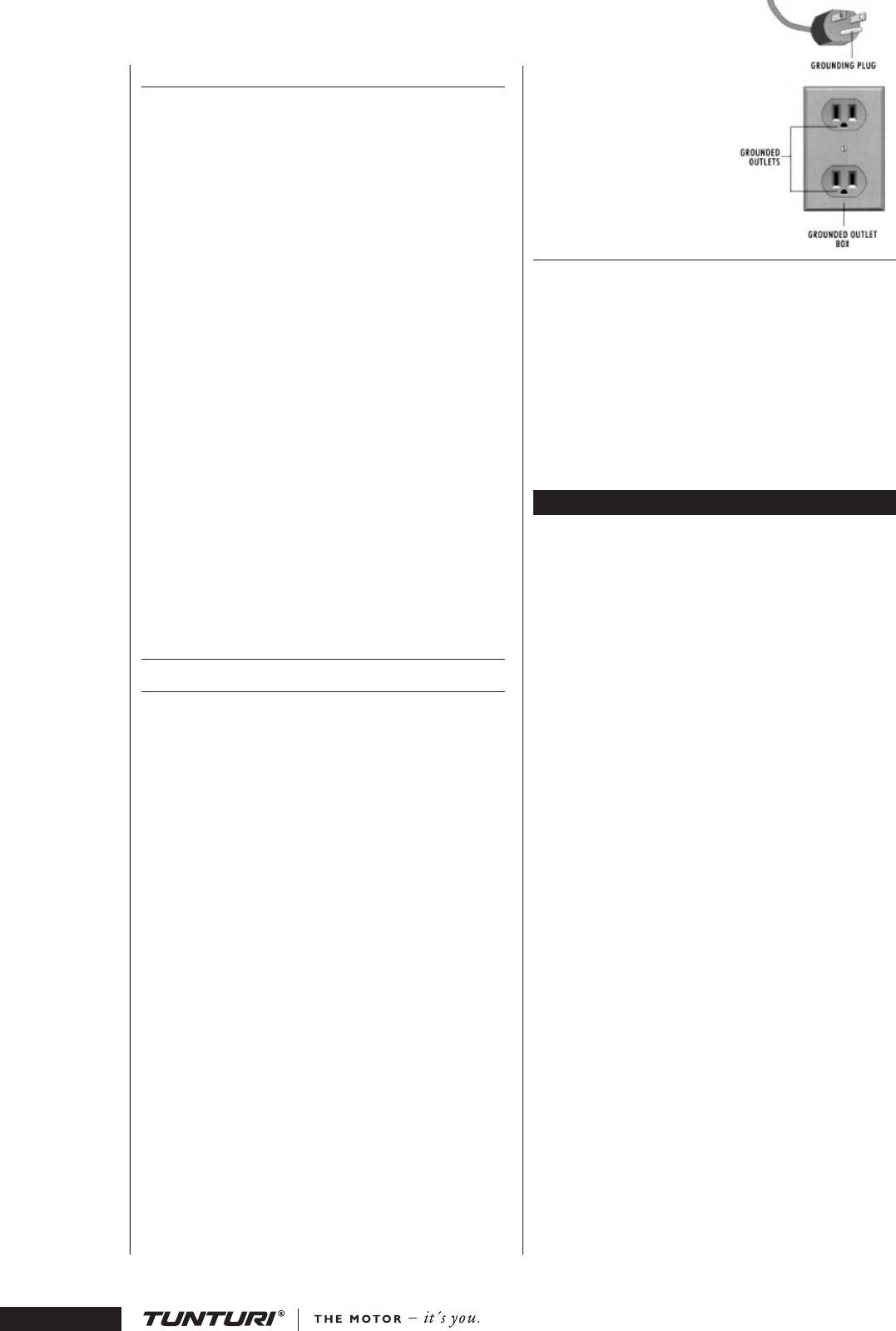
4
OW NER 'S MAN UAL • J9 • J 9F
J9F: HAND RAIL AND INTERFACE
(FIGURES 3, 4, 5 AND 6)
Turn the user interface until the holes for the
locking screws are in position and then attach by
tightening the 4 screws (M6x12) on the rear side.
Cut the hand rail ribbon and place 2 pieces of
styrox foam under the front end of the treadmill.
Attach the folding frame to the treadmill with
3 Allen screws (M6x16) on both sides. Remove
the styrox foam pieces. The running base must be
held up during the gas spring installation, so you
will need another person to support the running
base. Thread the upper end of the gas spring (M8
thread) completely into the hexagonal bushing.
NOTE! Attach the gas spring below the locking
fork. Thread the gas spring by hand; do not use
tools as these may damage the piston rod. Attach
the lower end of the gas spring to the folding
frame with an M8 screw and a nut. Lower the
running base carefully and place the multi-purpose
rack with the plastic end pieces on the top of
the hand rail, pull the lower edge of the rack
over the support bolts on the hand rail sides and
attach the plastic end pieces with screws to the
top of the hand rail. Attach the 2 screws (M6x12)
on the front side of the interface and remove the
protective lm from the display.
POWER CORD AND
GROUNDING INSTRUCTIONS
Plug the socket end of the power cord into the
treadmill at the lower right front corner. Before
connecting the device to a power source, make sure
that local voltage matches that indicated on the
type plate. The treadmill operates at either 230 V
or 120 V (US-version). Turn on the power using
the switch next to the socket on the treadmill.
This treadmill must be grounded. If it should
malfunction or breakdown, grounding provides a
path of least resistance for electrical current to
reduce the risk of electrical shock. This product
is equipped with a cord having an equipment-
grounded conductor and a grounding plug.
The plug must be plugged into an appropriate
outlet that is properly installed and grounded in
accordance with all local codes and ordinances.
Do not use extension cables when connecting the
equipment to the power source.
DANGER! Improper connection of the
equipment-grounding conductor can result in a
risk of electric shock. Check with a qualied
electrician or serviceman if you are in doubt as to
whether the product is properly grounded. Do not
modify the plug provided with the product - if it
will not t the outlet, have a proper outlet installed
by a qualied electrician.
NOTE! The version for use on a nominal
120-volt circuit has a grounding plug that
looks like the plug
illustrated. Make sure that
the product is connected to
an outlet having the same
conguration as the plug.
No adapter should be used
with this product.
SAFETY TETHER KEY
The treadmill cannot be used if the tether key
is not properly installed in the meter base; if the
key is removed from its place near the electronic
display, the treadmill will immediately stop. Insert
the safety tether key into the meter base. Ensure
that the clip of the safety tether key is properly
attached to your clothing; as the cord tightens,
make sure the clip does not detach itself from your
clothing before the safety tether key disconnects
from the user interface.
E X E R C I S I N G
No matter what your goal, you’ll get the best
results by training at the right level of effort,
and the best measure is your own heart-rate. First
nd your maximum heart-rate i.e. where the rate
doesn’t increase with added effort. If you don’t
know your maximum heart-rate, please use the
following formula as a guide:
Women: 226 - age Men: 220 - age
These are average values and the maximum varies
from person to person. The maximum heart-rate
diminishes on average by one point per year. If you
belong to one of the risk groups mentioned earlier,
ask a doctor to measure your maximum heart-rate
for you. We have dened three different heart-rate
zones to help you with targeted training.
Beginner: 50-60 % of maximum heart-rate
Also suitable for weight-watchers, convalescents
and those who haven’t exercised for a long time.
Three sessions a week of at least a half-hour each
is recommended. Regular exercise considerably
improves beginners’ respiratory and circulatory
performance and you will quickly feel your
improvement.
Trainer: 60-70 % of maximum heart-rate
Perfect for improving and maintaining tness.
Even reasonable effort develops the heart and lungs
effectively, training for a minimum of 30 minutes
at least three times a week. To improve your
condition still further, increase either frequency or
effort, but not both at the same time!
Active trainer:
70-80 % of maximum heart-rate
Exercise at this level suits only the ttest and
presupposes long-endurance workouts.

















